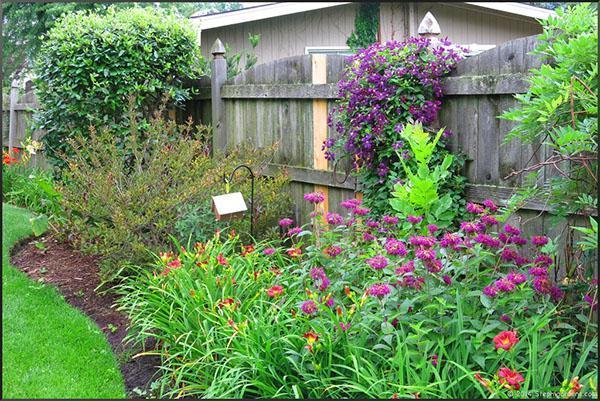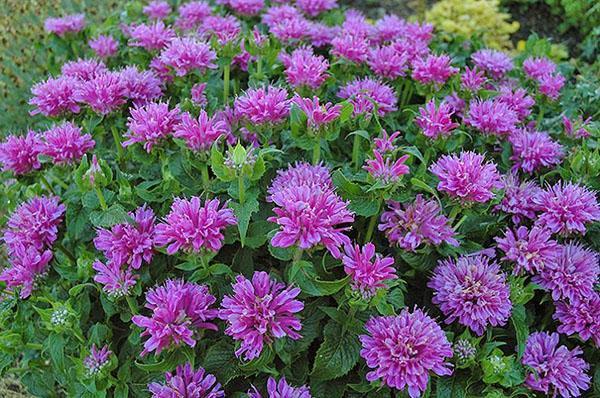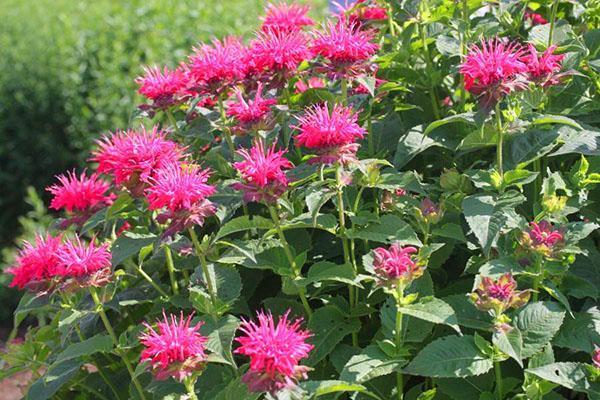We grow monarda in our garden without problems
 Lipocytes are represented quite widely, among them the monard stands out, planting and caring in the open field for which will not cause much trouble. The plant is very picky, looks great both in single plantings and in compositions with other species.
Lipocytes are represented quite widely, among them the monard stands out, planting and caring in the open field for which will not cause much trouble. The plant is very picky, looks great both in single plantings and in compositions with other species.
A bit of history

In Europe, the plant was grown more as an essential oil, but since the 19th century, the monarda has become very popular. It is better known as bergamot, lemon mint and American lemon balm.
Description
 Monarda can be both annual and perennial. All its species are quite tall, erect stems can reach 1-1.2 m.The bush has the following characteristics:
Monarda can be both annual and perennial. All its species are quite tall, erect stems can reach 1-1.2 m.The bush has the following characteristics:
- The leaves are oblong, with teeth along the edge, have a green color, are distinguished by a strongly pronounced specific smell, according to which it is difficult to confuse the monarda.
- Flowers are small, two-lipped, can be white, purple, lilac, yellowish. The inflorescences are dense, collected in tassels or heads up to 8 cm in diameter.
- The seed is hidden in the nut, it can germinate in three years.
Transplant the monarda regularly, in one place a fragrant bush is grown for no more than 7 years, then it is imperative to change the location.
Planting methods
Planting in open ground and subsequent care for the monard can be done both in spring and before winter, and propagated in three ways:
- Sowing seeds. This method does not guarantee the preservation of all characteristics, the color of flowers can be very diverse. Monarda is grown through seedlings more for experimental purposes. Crops sprout slowly, growth acceleration occurs only after the appearance of the third pair of leaves.

- By dividing an adult bush, you can achieve flowering shrub the next year after planting. An adult healthy plant perfectly tolerates the process of division and takes root in correctly selected soils almost immediately.

- Cuttings are not very common among gardeners, perhaps due to the need for a little tinkering. But the seedlings take root well and develop quite quickly.

Everyone chooses the most suitable for themselves, but further care will always be the same.
Drop off time
 Planting and caring for the monard in the open field will not give much trouble. When is the best time to plant? It all depends on the method.
Planting and caring for the monard in the open field will not give much trouble. When is the best time to plant? It all depends on the method.
If you decide to propagate the plant by cuttings, then planting will have to be carried out in the autumn. Reproduction by dividing an adult bush is carried out both in the spring and before winter. Seedlings are planted mainly in early summer.
The preparatory process is carried out for all types of reproduction, it consists of the following stages:
- Digging places before disembarking.
- Introduction of mineral and organic fertilizers.
- Abundant watering.
If you plan to plant in the spring, such manipulations should be carried out in the fall. This will remove weeds from the area and slightly loosen the soil.
 Monarda is planted in open ground in spring through dividing the bush. To do this, dig it out, wash the rhizomes and carefully cut into several pieces of approximately the same size. Slices are processed ash and charcoal, placed in pre-prepared pits and sprinkled with earth. After that, the bushes must be thoroughly watered.
Monarda is planted in open ground in spring through dividing the bush. To do this, dig it out, wash the rhizomes and carefully cut into several pieces of approximately the same size. Slices are processed ash and charcoal, placed in pre-prepared pits and sprinkled with earth. After that, the bushes must be thoroughly watered.
Monarda prefers neutral or alkaline soils; an acidic plant will grow and develop poorly.
Planting and leaving in the open ground for the winter monarda is carried out without any particular difficulties. During this period, reproduction is carried out by rooted cuttings or by dividing an adult bush.
The plant is planted in pre-prepared soil in early autumn, when it is still far from frost.
Monarda is planted at a distance of at least 60 cm from each other, the plant grows very quickly and takes up all the free space.
Care
 In order for the monard to grow well and develop, it is necessary to provide it with proper care, which consists of:
In order for the monard to grow well and develop, it is necessary to provide it with proper care, which consists of:
- in regular watering plants, especially in the hot season of summer, otherwise there is a threat of powdery mildew on the leaves and shoots;
- loosening the soil near bushes, removing weeds;
- the introduction of mineral and organic fertilizers;
- prevention of diseases every spring with the help of foundation or copper sulfate.
In very hot summers, the land around the monarda bush must be mulched with peat or leaf humus.
Sawdust for mulching cannot be used, they can lead to the death of the plant.
Pests and diseases
The fragrant bush is resistant to various diseases, an exception may be powdery mildew, but it can occur only when there is a lack of moisture in a particularly dry season.
Nobody is afraid of monarda pests, the smell of its flowers and leaves scares away any insects. Having planted such a bush near a bench in the garden, you can sit there on long summer evenings and not be afraid of mosquitoes.
Planting and leaving a perennial monarda in the open field is simple, as evidenced by numerous photos of the plant.